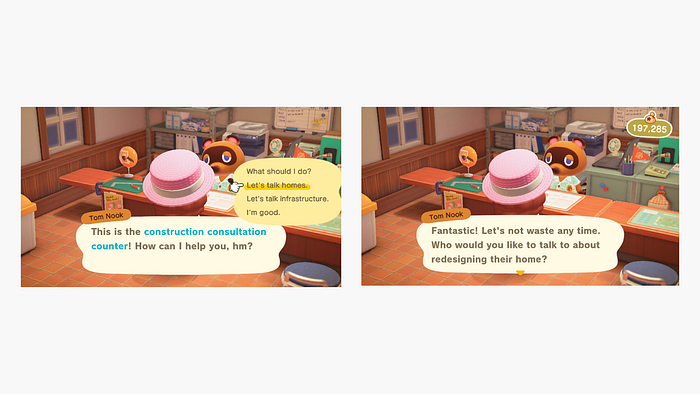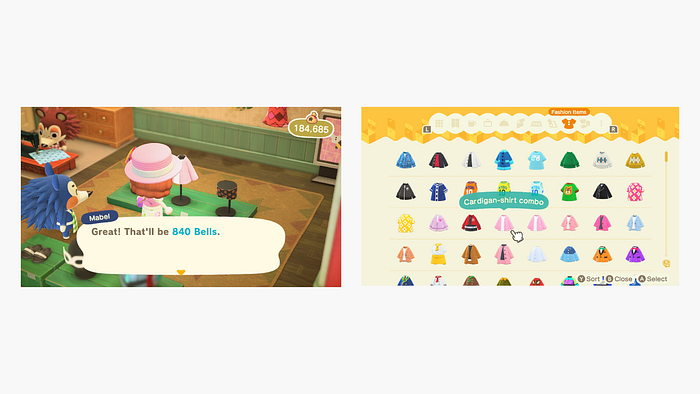

What Animal Crossing teaches about the power of defaults | UX Collective
source link: https://uxdesign.cc/what-animal-crossing-can-teach-you-about-the-power-of-defaults-95e444e865bd
Go to the source link to view the article. You can view the picture content, updated content and better typesetting reading experience. If the link is broken, please click the button below to view the snapshot at that time.

What Animal Crossing can teach you about the power of defaults
And best UX practices in conversion rate optimization.

Photo by Sara Kurfeß
Despite being originally created as a cheerful, social simulation game series for children, Animal Crossing has settled as one of the most popular Nintendo games for adults. Since the first release in 2001, the game’s been sold in over 70 million units. The last of the series, New Horizons, broke the previous record for most Nintendo Switch game copies sold in a single month, selling over 40 million units.
In the age of a pandemic-struck world, social distancing, and distress, Animal Crossing has brought comfort and happiness to players’ lives over the last few years. As a psychologist, Dr. Rachel Kowert points out:
“During lockdowns, people were very self-aware that they were loving Animal Crossing because it was meeting three needs: being in control, being good at things, and having friends when those three needs could not be as well met at other places.” — Source
As a player myself, I find Animal Crossing emotionally soothing and relaxing because of the lack of violent elements. Even an occasional encounter with a tarantula running around your island in late evening hours, innocently ends with restarting the game.
Instead of mimicking real life, Animal Crossing focuses on showing the beauty of simple moments in life, such as the passing time. For instance, you can gradually watch how seasons slowly change from spring filled with cherry blossom petals to a cold and snowy winter.
What about UX and UI?
In terms of the overall gaming experience, Animal Crossing offers a wide variety of unique features that simply make your gaming time joyful. No one can deny that New Horizons is packed with visually appealing microinteractions, amusing copy, and accurately selected sounds.

Amusing conversations with Blathers at the museum
For example, when the player travels to another island and has to wait until the new island loads, there is a loading screen with a pleasing animation of a bird’s spinning wings reminding of propellers in an airplane.

Dodo Airlines in Animal Crossing: New Horizons
On top of that brilliantly crafted concept, players can hear nothing else but a raspberry sound (also known as THBBPTHBPT, razzberry, or tongue farting if you’d prefer). What can be more fun than adding that sound effect to accompany an “airplane” animation promoting Dodo Airlines?
However, Animal Crossing is not just a masterpiece crafted by phenomenal copywriters and UI designers. If you analyze the game closely, you can also notice quite a few clever conversion rate optimization tricks that encourage you to purchase more goods and spend your Bells.
Conversion optimization tactics in Animal Crossing: New Horizons
Animal Crossing revolves around the power of defaults, meaning that the most desired or pre-selected by the game makers options occupy the top positions in a selection window. The default effect is a concept deriving from behavioral economics. It explains that people generally accept the default — first — option when they don’t have any defined preference.
“Default options are pre-set courses of action that take effect if nothing is specified by the decision maker.” Thaler & Sunstein, 2008
In the context of web analysis and e-commerce, even Nielsen Norman Group scrutinized that pattern and published an article explaining how people make decisions while browsing websites and often select the default and suggested options.
This tactic is widely present in New Horizons. As a result, a player who isn’t sure which option to select or — in the case of a younger player — doesn’t understand all words used on the screen — can opt for choosing a default option. However, default options aren’t always favorable to the user or player. They rather act as suggestions and instructions showing what to do next in a specific journey. In Animal Crossing, defaults often also work as conversion rate drivers encouraging players to finalize their purchases.
1. Redecorating homes
To begin with, let’s look at what happens when you speak to Tom Nook about your intention of redecorating your villager’s house. In the beginning, you’re asked to select a villager whose home you’d like to redecorate.

Construction consultation counter in Animal Crossing: New Horizons
If you look closely, you will notice that there is no preview showing you which building you’re selecting. Subsequently, you can easily make the mistake of choosing the wrong villager and building. But once you choose a name, you have to go through the entire redecorating process, even if you don’t want to change anything in that particular building.

Redecorating homes in Animal Crossing: New Horizons
Unfortunately, you’re also forced to pay upfront for the services before you even begin redecorating the house or check if you selected the right building.

Redecorating homes in Animal Crossing: New Horizons
Even though I was very close to categorizing that experience as a dark pattern because I had made that mistake at least once in the past, when I was taking screenshots, I finally found a way to reverse my mistake and request a refund from Tom Nook during the redecoration or — in my case — non-redecoration process. However, it isn’t displayed either as a default or the last option (usually reserved for canceling plans), which is why it’s easy to miss it entirely. It’s the third option: “I’m quitting.”

Redecorating homes in Animal Crossing: New Horizons
Although it may seem obvious now as I’ve attached the screenshot above, this is the only point in the journey when I can call off my redecoration project without losing Bells. Even when I approached Tom Nook to sign off the designs without making any single fix, the default option didn’t change, suggesting that I should still pay for making no amendments.
Moreover, the “I’m quitting” option can also sound ambiguous to an average player, and it may imply that you’d still be charged for making no changes. Although technically it should’t be the case, the screen prompts you to still select the first option suggesting it’s the most reasonable one. However, in this case, opting for the default selection will cost you 9000 Bells.
3. Purchasing fake art
In Animal Crossing: New Horizons, you can also run into a sneaky merchant named Cousin Redd, who sells various pieces of art. The trick is that the artworks he sells are not always genuine, and you always have to carefully scrutinize each work individually to ensure you don’t purchase a fake piece. There are generally two ways to verify if it’s genuine — you can either google the difference or finalize your purchase and bring it a day later to your museum for verification.

Purchasing fake art from Redd at Animal Crossing: New Horizons
Even in the case of purchasing art — whether genuine or not — Cousin Redd tries to convince the player to make a purchase. When he asks if you’d like to buy a piece, the selection window shows the “You got a deal” message as one of the three options you have, and unsurprisingly, it’s the default option. As a result, you may accidentally click too fast while the message is still loading and select that option out of speed if you’re not careful enough.

Purchasing fake art from Redd at Animal Crossing: New Horizons
3. Repurchasing the same clothes over and over again
If you’ve ever played Animal Crossing, you can probably relate to this point. There’s no way to verify if you already have certain pieces of clothing in your wardrobe when you purchase extra items. Because of that, you can end up multiplying the same products in your storage.

Purchasing clothes at Able Sisters
When you shop at Able Sisters and the Apparel Shop at the Happy Home Paradise resort island, all the assistants are kind and convince you to finalize your purchase. The only obstacle from the player’s perspective is the lack of any visual indication suggesting which items you already possess.

Purchasing clothes at Able Sisters
This is a quite different experience compared to shopping in real life when you look at your wardrobe every day and you recognize what models of shoes or colors of shirts you already have. Inside a game, especially in Animal Crossing, you don’t browse your storage that often to memorize all items and color variants you possess. Going through all your items becomes even more exhausting when you have over a thousand objects of different categories inside, ranging from chairs to plant seeds.

Purchasing clothes at Able Sisters vs. player’s storage
Because of that, we shouldn’t rely solely on players’ memory, especially when we know they take breaks from playing, shorter or longer. Nevertheless, the shop assistants always encourage players to buy all pieces of clothing by default, convincing them to make the mistake of purchasing the same item over and over again.
Key takeaways
Animal Crossing: New Horizons is a brilliantly designed game that can teach a lot about the importance of sound selection, microcopy, and microinteractions. On the flip side, it also proves how the power of defaults can be used inside a game to encourage players to convert when they aren’t entirely sure what they should do next. Instead, a default selection serves as a suggestion and an instruction to the player — or user — on how to proceed in the journey.
Recommend
About Joyk
Aggregate valuable and interesting links.
Joyk means Joy of geeK